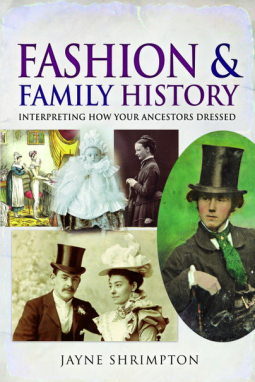 |
Fashion and Family History
by Jayne Shrimpton ISBN-13: 9781526760265 Paperback: 200 pages Publisher: Pen and Sword Released: January 30th 2021 |
Source: ebook review copy from the publisher through NetGalley.
Book Description, Modified from Goodreads:
As Britain evolved during the 1800s from a slow-paced agrarian society into an urban-industrial nation, dress was transformed. Traditional rural styles declined and modern city modes, new workwear and holiday gear developed. Women sewed at home, while shopping advanced, novel textiles and mass-produced goods bringing affordable fashion to ordinary people. Many of our predecessors worked as professional garment-makers, laundresses or in other related trades: close to fashion production, as consumers they looked after their clothes.
The author explains how, understanding the social significance of dress, the Victorians observed strict etiquette through special costumes for Sundays, marriage and mourning. Poorer families struggled to maintain standards, but young single workers spent their wages on clothes, the older generation cultivating their own discreet style. Twentieth-century dress grew more relaxed and democratic as popular culture influenced fashion for recent generations who enjoyed sport, cinema, music and dancing.
My Review:
Fashion and Family History describes British fashions from 1800 to 1950. The author first described women's dress, men's dress, and children's dress (including babies) and how it changed throughout these years. She then went into more detail about the differences between city fashions and what rural people would wear, what was worn for business, uniforms for servants, department store employees, etc., what made up "Sunday best" clothing, what was worn for travel and holidays, sports (horseback riding, tennis, cycling, motoring, golf, walking), for brides at weddings, mourning attire, and evening dress. She also talked about activities that involved fashion and clothing, like sewing, being a seamstress or laundress, the rise of patterns and sewing machines, knitting, etc. She also described the care of clothes of different materials: how it was washed, ironed, starched, and stored.
There were some photographs and fashion plates showing the different fashions, but there were not very many of these. There were more for the 1900s than the 1800s, and even there, the photos did not show every change of fashion. Overall, the descriptions were clear enough that I could identify the clothes in the photographs. Since the aim of the book is helping people date old photos and paintings by the fashion, it should be helpful in that regard. I got this book because I was interested in seeing what the different fashions looked like, so I was disappointed that there weren't more fashion illustrations and photographs included.
If you've read this book, what do you think about it? I'd be honored if you wrote your own opinion of the book in the comments.
































